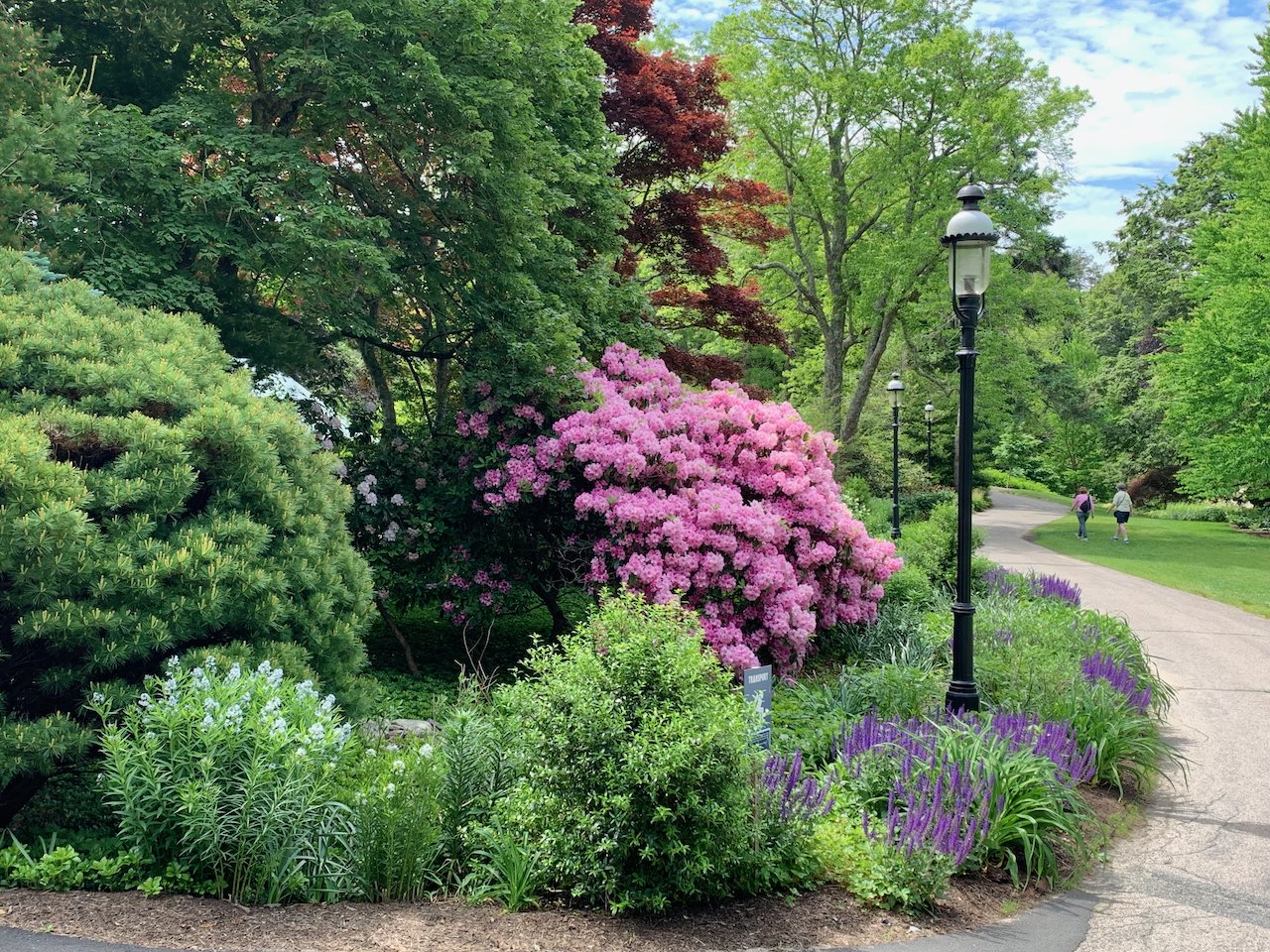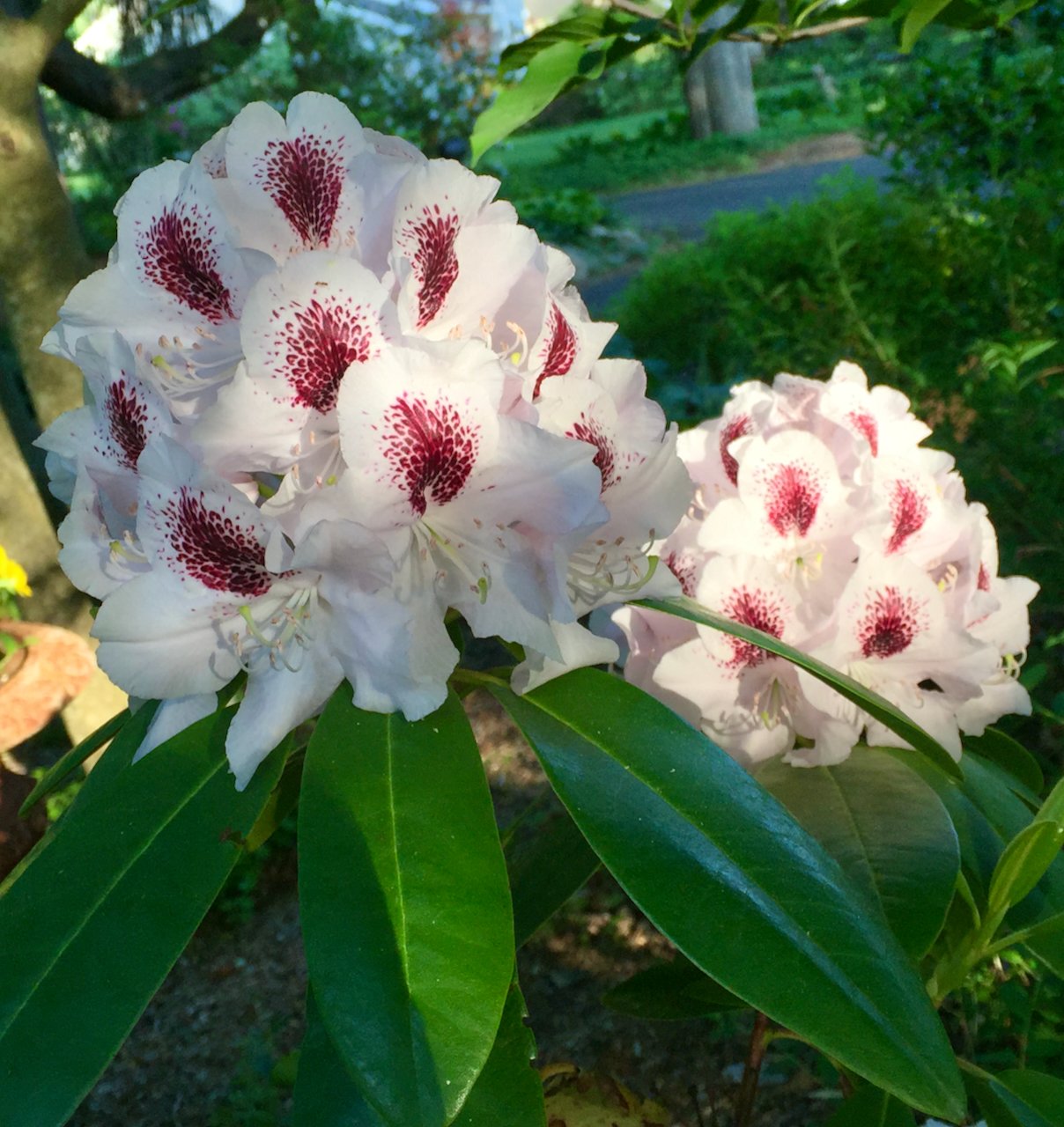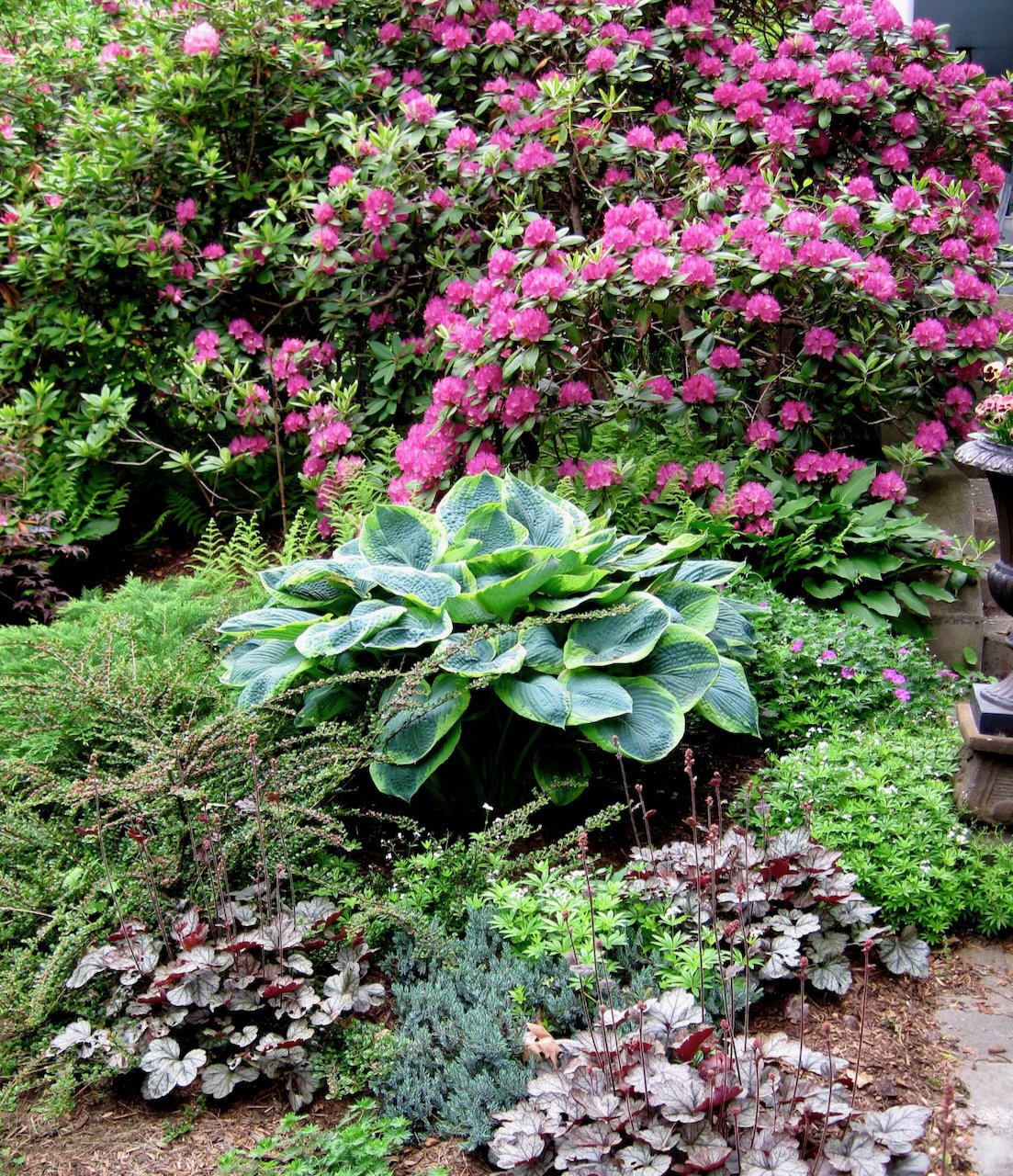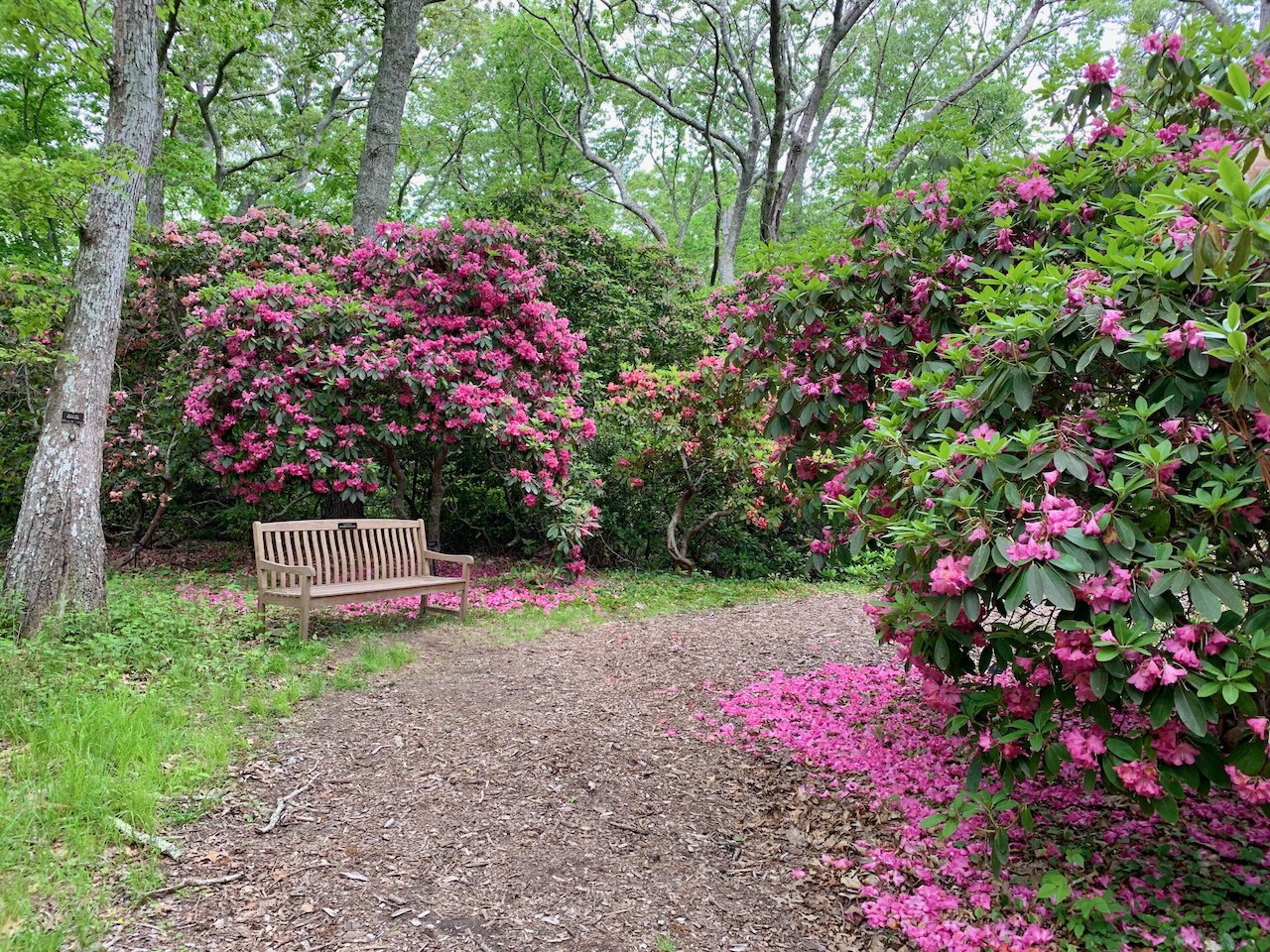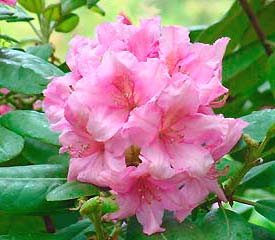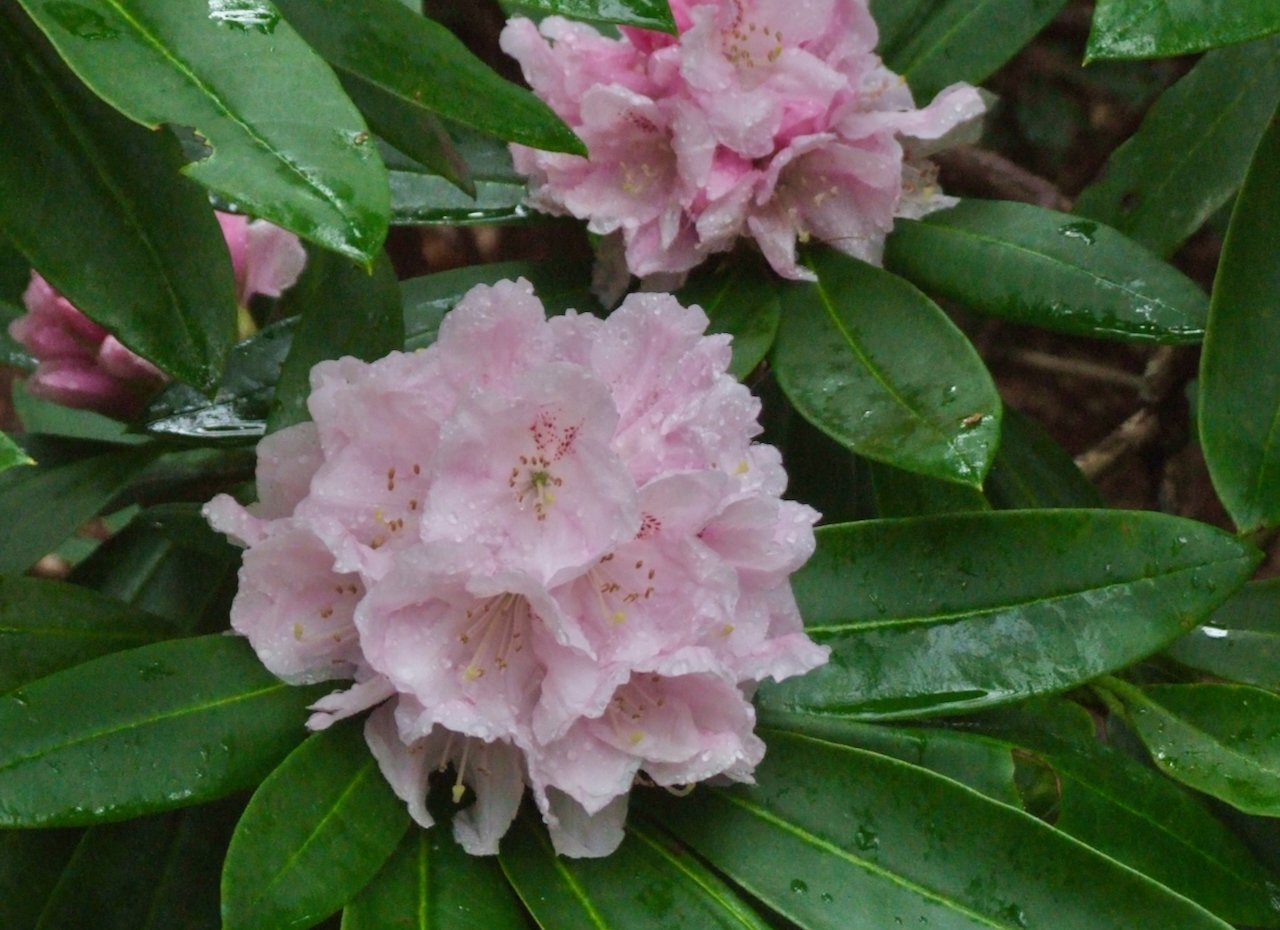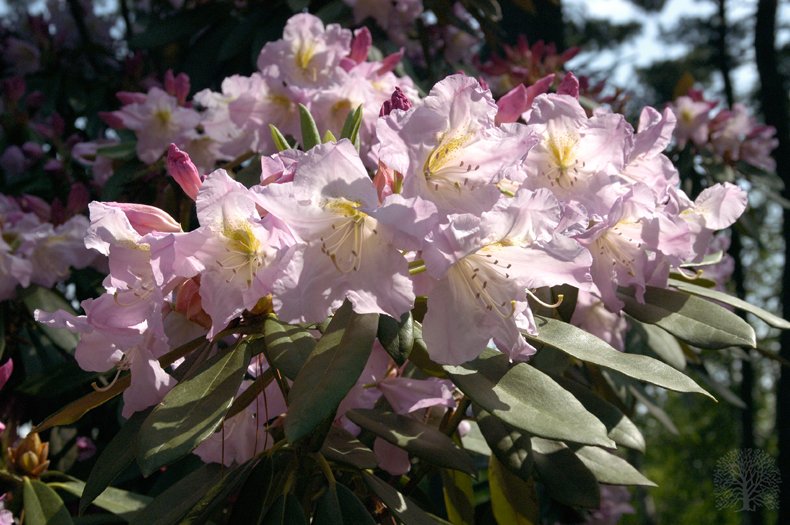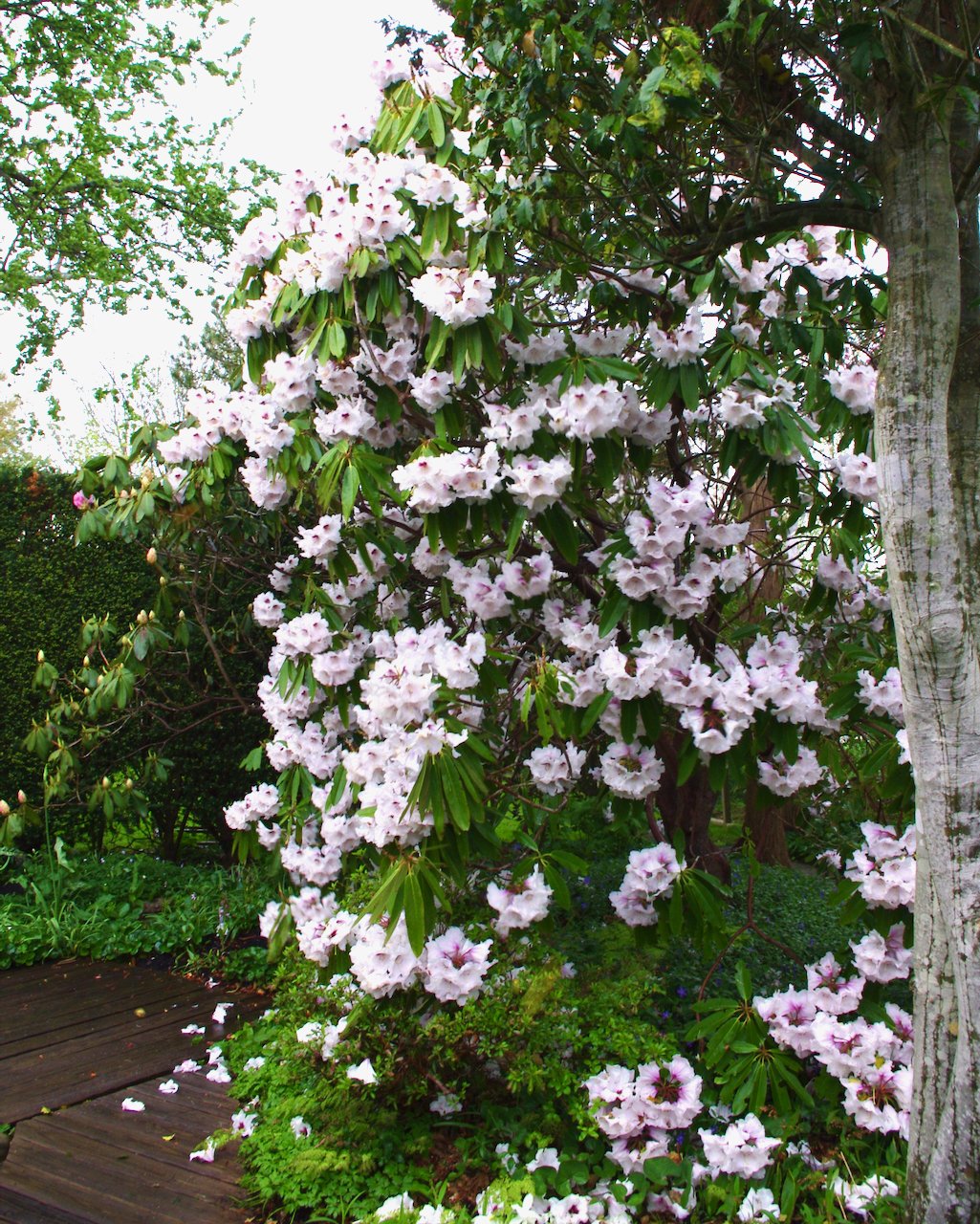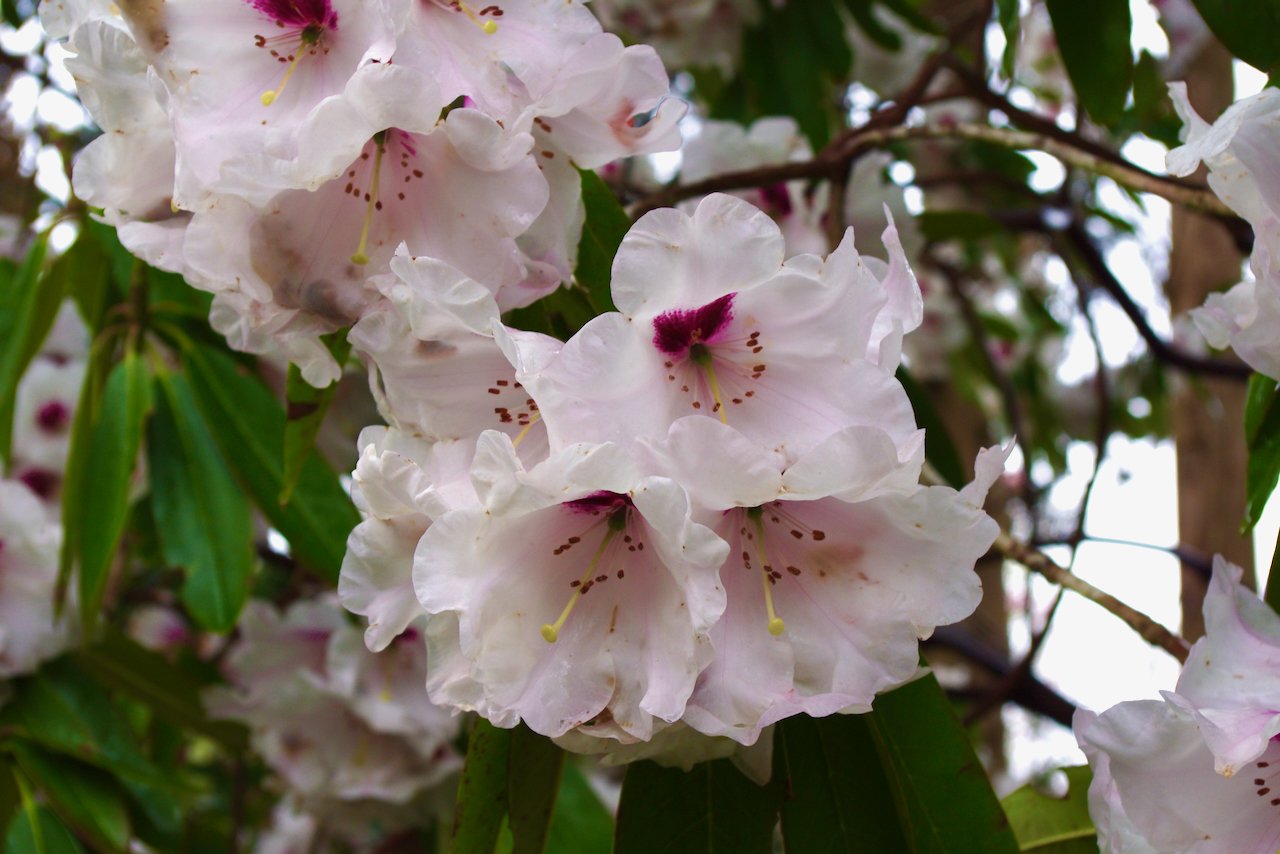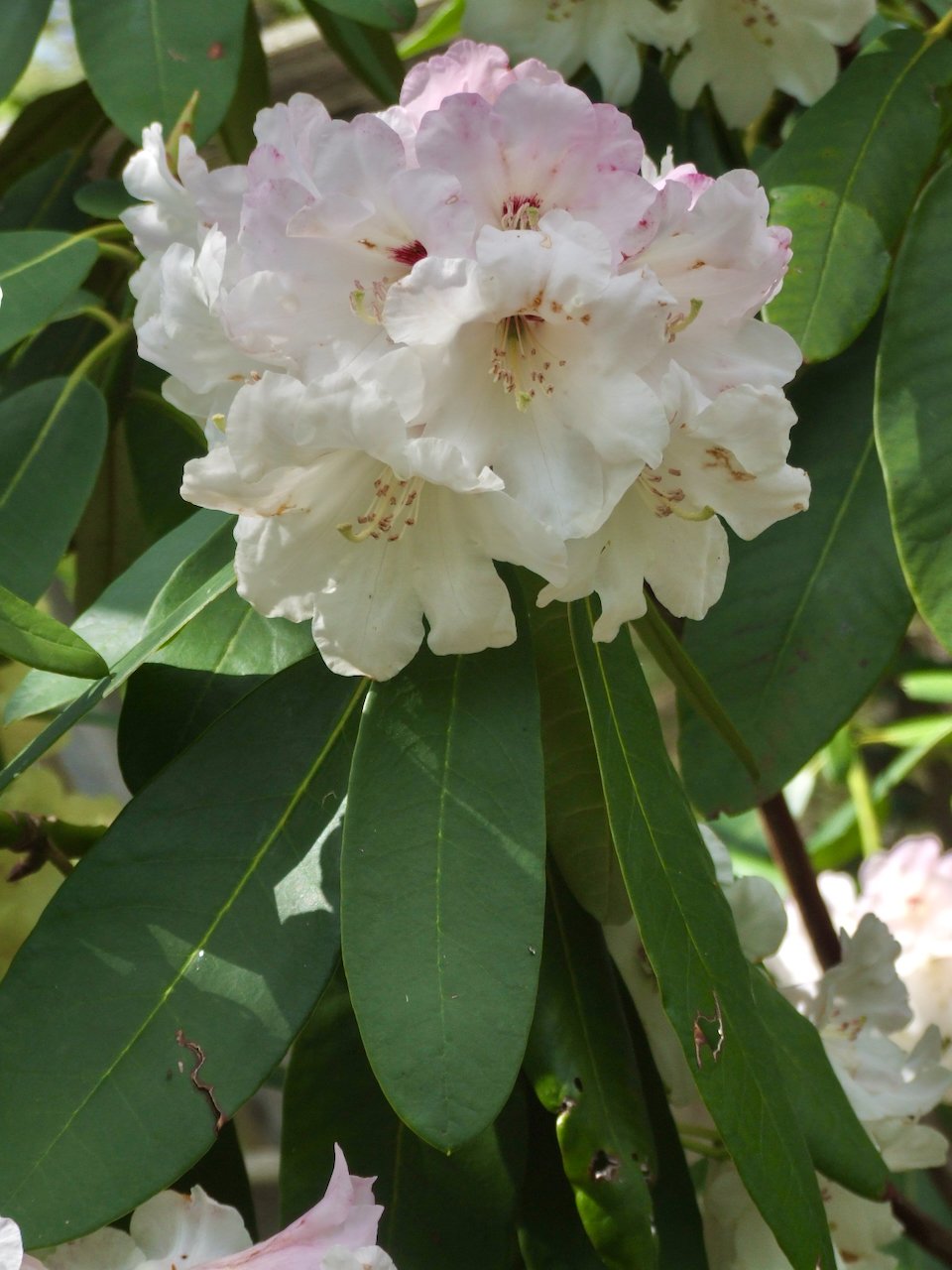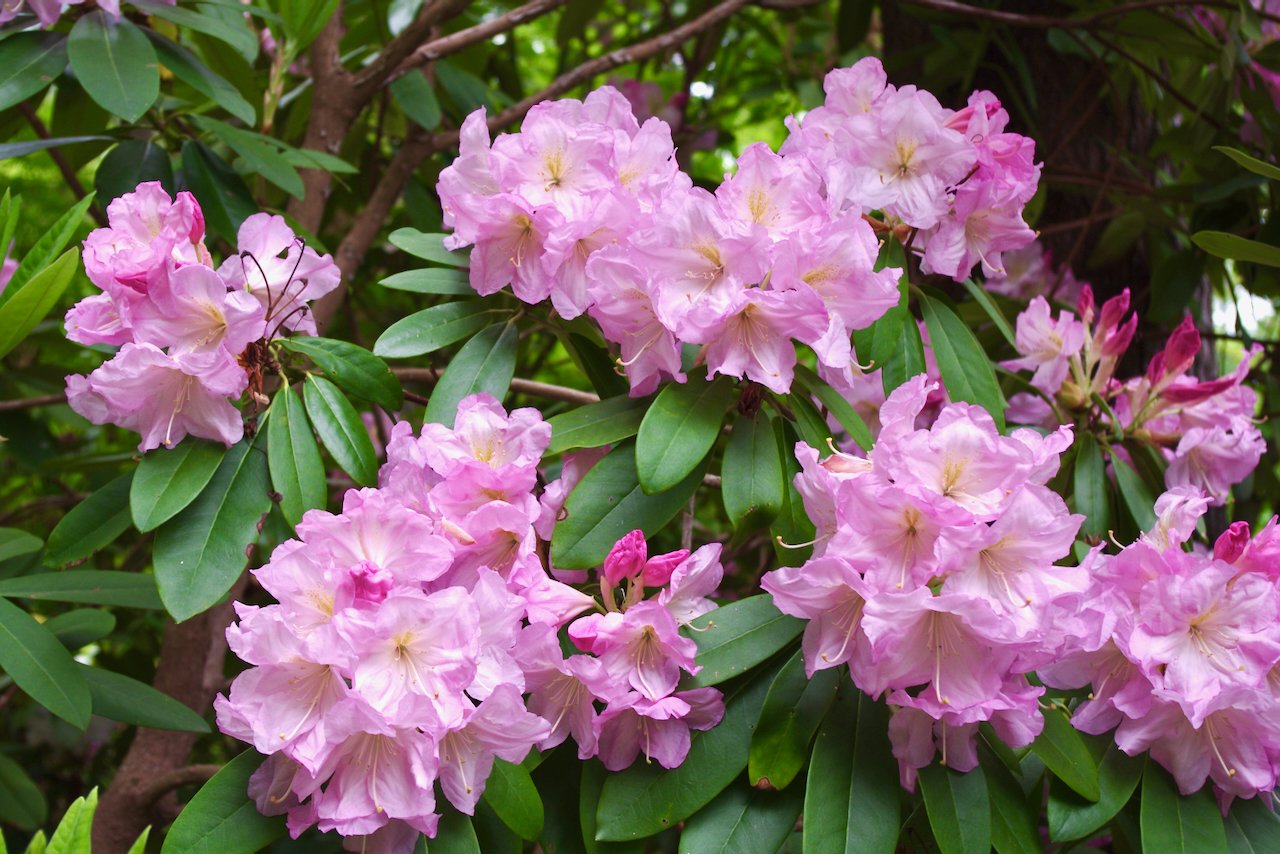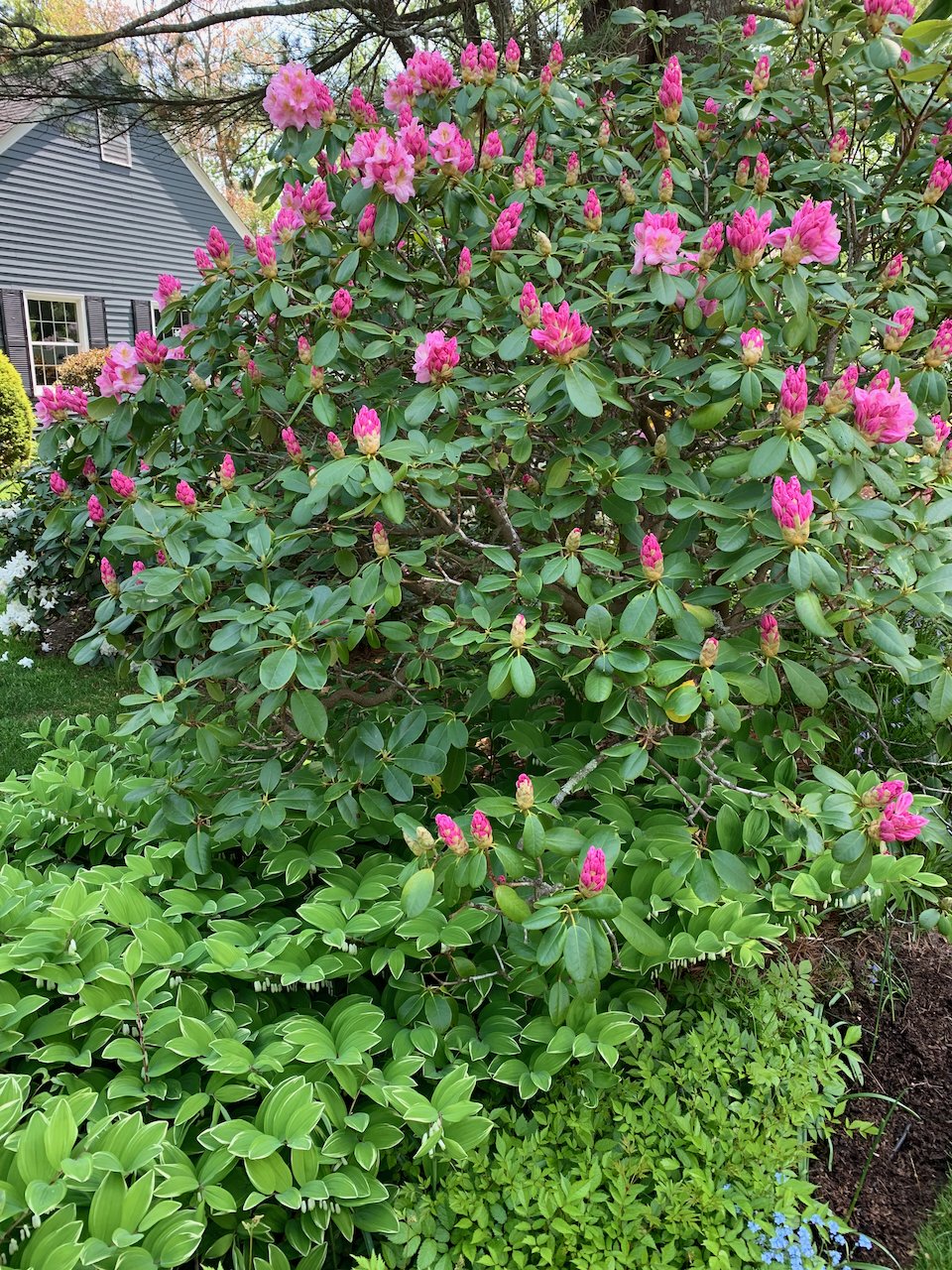Big Rhodys
/heritage museums and gardens, photo by jana milbocker
By CJ Patterson
A number of years ago, I was selling a rhododendron to a citizen, and he was thrilled with it. It was Calsap (Catalgla X Sappho), a large frilled white with a dynamite purple-black blotch, very showy. He had seen it in our flower show and was smitten. He had asked about it, and was told “it will be hard to find”. As he picked it up to head for the cash register, I remarked “it gets big, so be careful where you site it.” He froze in mid-lift and turned. “What do you mean, big?”
calsap, photo by jana milbocker
And so it begins. Breeding with R. yakushimanum, R. brachycarpum, and other compact, slow-growing hybrids has changed our aesthetics in the garden. Nowadays, if it isn’t a little green toadstool, no one knows what to do with it. We really do need to cultivate some creativity in our garden design. One of the most fun things about Rhododendrons is their sheer variety. Every natural plant form from hedging, groundcovers, and foliage accent to small trees can be found amongst the rhodys right along with the standard rounded green shrub. All it takes is a little imagination to use them.
photo by jana milbocker
My Calsap loving customer had a small suburban garden, and I think the term “gets big” suggested a giant shambling mound that would eat the dog. I admitted that Calsap could indeed fill that description, but that it would take it a number of years to make it to the dog-eating stage, and in the meantime, if he gave it a good site with a half day of sun, and regular deadheading, he could look forward to being the envy of the neighborhood for two weeks every year for quite a while. Personally, I like a really big rhododendron. Something about a tree-form rhododendron that you can stroll under is irresistible to me. Like an evergreen magnolia, only better because it’s a rhododendron. And then once a year, it blooms gloriously, not a flower here and there like the magnolia, but great masses of bloom. Anyone who owns a mature “Andy Paton” will know what I mean.
heritage museums and gardens, photo by jana milbocker
And they can be so useful. Big rhododendrons can be used as accent plants, or hedging, or blocking a nasty view. They are good for anchoring beds, be they wildflower, perennial, or rhody collection. I speak here of the varieties that have a naturally upright growth habit, with a solid scaffolding of branches that can be pruned up a bit to allow for air circulation and “head space” for underplantings. But which to choose? There are so many fine varieties to choose from! In no particular order, here are some suggestions for a “big” rhody. All are dependable healthy solid citizens, hardy to at least USDA zone 6, and several to zone 5 or lower.
cadis, photo courtesy cornell university
Cadis (Caroline X R. discolor) is an old Gable hybrid that has stood the test of time, and is now considered a standard. A sturdy upright grower with strong crotches, it will reach 6-8 feet in ten years and bears copious masses of candy pink flowers in late midseason, as shown in the picture to the right. It takes good disease and drought resistance from the pod parent Caroline (an earlier hybrid of Gable which is famous for its ability to turn away the slings and arrows of outrageous weather) and an upright tree form habit and later bloom period from the pollen parent, R. discolor.
Wyandanch Pink, courtesy ARS
Wyandanch Pink is one of the fastest and largest growing Dexter hybrids. A mature specimen can have multiple upright trunks 4” or more in diameter. Add to this hardiness to at least USDA zone 5, and you have a good candidate for the colder garden. It is one of the hardiest Dexters we can recommend for western Massachusetts and southern New Hampshire. Its main flaw is that because it is such a fast grower and grows so large, that it can have brittle wood. For this reason I do not recommend planting it under white pines or where it will catch the wind.
Spellbinder, photo by CJ patterson
Spellbinder is a very large growing hybrid by Leach {(R. maximum X Russell Harmon) X (R. calophytum X sutchuenense)} that was bred for a tree form plant. It has plenty of hardiness from the pod parent, and a solid tree form from the pollen parent to give a sturdy tall upright plant. It does not root easily from cuttings, so it may take a little searching for, but I have seen it in nurseries. It is hardy in zone 5 and should have at least a few hours a day of sun to bud up well.
katherine Dalton, courtesy Cornell university
Katherine Dalton is a Canadian hybrid of R. smirnowii and R. fortunei and taking the best from each parent. A healthy hardy strong growing plant, with good clean foliage and well clothed, a dense upright plant with a shared leader, very resistant to snow load and windstorms. It does not set many seedpods and so does not need much deadheading, a happy characteristic in a plant you need a stepladder to deadhead.
Now we reach the varieties that, while splendid, may take a bit of searching, but they are totally worth the trouble.
Babylon, photo by CJ patterson
Babylon (R. calophytum X praevernum). This is a famous plant, found in many collections, but almost unknown in the standard nursery trade, probably because it takes a while to mature to a flowering specimen. To become a convert, try looking at the specimen plant at Sakonnet Gardens in RI shown in the picture to the right. It needs a sheltered position as it blooms very early, with enormous trusses of white with a large jewel red blotch cascading over the plant. It is hardier than you would expect from the parentage, and I have seen trusses from west of I-495 and from southern NH, but their growers have been careful to provide both light shade and good air drainage. Even so, late frosts may ruin your show, although it seldom injures the plant.
babylon, photo by CJ patterson
Atroflo I and II (R. atrosanguineum X floccigerum) Another antique from Gable that is an ideal beginner’s plant for a tall rhododendron. It is an excellent foliage plant with long slender leaves of dark green with fairly thick indumentum beneath. It flowers freely with at least a half day of sun, bright rose in a medium sized truss, and the petals look like they were made of crinkly tissue paper. Habit is upright to a fault, growing up before filling out. Branches that touch ground layer easily and then reach for the sky, forming a separate leader. An Atroflo neglected in a large planting will form a little woods of its own, shading out its neighbors. Unfortunately, mine never seem to get much more than 15 feet or so tall, but perhaps they are not ideally situated. Atroflo I was the first to be selected from the seedlot for floral characteristics, but later Atroflo II was selected as being not quite as tall, but hardier. Other than that, they are nearly identical in the garden.
hardy giant, photo by cj patterson
Hardy Giant (R. fortunei X fictolacteum) One of the earliest attempts to produce a hardy tree rhododendron, this uses R. fortunei as a pod parent for hardiness and fictolacteum as a pollen parent for size, as it is a true tree species related to R. rex. Unfortunately, the enormous leaves of the pollen parent did not come through, but it did yield a handsome sturdy upright plant with good foliage (though not overlarge) and a growth habit that grows up about twice as fast as it grows sideways. It blooms in early midseason with ample trusses of white flowers tinged pink. Solidly hardy to zone 5b and probably more, given a sheltered position with good air drainage. Our first plant grew to 12 feet in 20 years from a cutting, almost twice as tall as wide.
Russell Harmon, photo by cj patterson
Russell Harmon is a hybrid of our two native broadleaves, R. catawbiense and maximum and was introduced by La Bar’s nursery in the 1950s. It is about as hardy as you will get in a large rhododendron, down to -25F or better, and once established, is pretty bulletproof for a tall rhododendron. It roots easily and does not seem to be much discouraged by drought, once established. Personally, I think this rhody would be the poster child for the term “abundanza”, growing ten feet tall and fifteen feet wide, and once it reaches its maximum height it will continue to grow sideways. When it reaches its allotted space, it should be pruned. It will reward good light with very large trusses of magenta tinged flowers, not individually large, but plenty of them. It blooms late in the season, too late for most shows which is unfortunate, as its tall triangular trusses are much loved by judges.
duke of york, photo by CJ Patterson
Duke of York (R. fortunei X Scipio) Last but not least, one of my all-time favorite rhodys, an antique from the early days of hybridizing. Large flowers of pink with a slight tinge of magenta in lax but copious trusses, on a taller than wide plant, it is a healthy and long-lived vigorous variety bred in England but completely hardy in zone 5b here. When I was still working at the Arnold Arboretum, I found three of them at the base of Hemlock Hill that had been planted nearly 100 years earlier and were still in wonderful shape, at least twelve feet high and still blooming prolifically. I was thrilled to find that it roots easily and grows like a weed, and brought cuttings to P4M, where others shared my enthusiasm. Unfortunately, I made the major error of mentioning the plants to a garden designer, and she enthusiastically rerouted a major footpath right over them. In vain did I point out that rhododendrons do not like having their roots pummeled by traffic and that a stream of callous visitors would pull the plants down and rip off their stems (“there are so many flowers, no one will mind if I take a few” and rip them off they will do. I never mentioned a plant to upper echelons again.) I have not been back in many years, so I do not know if they are still there, but if they are, they are worth the extra hike when you visit the arboretum. The variety is so tall growing that I decided to experiment with it. I planted four rooted cuttings as a little grove, and then stood back to see how they would grow. The good news is that they grew into a wonderful grove that I could walk unimpeded under as though it were a grove of trees. The bad news is the closed canopy is very dense, allowing little light to filter down, and you cannot even tell when the plants are flowering except from a distance. And, of course no wildflowers or companion plants will grow under them.
scintillation, photo by jana milbocker
So I recommend tall rhodys to you as an accent plant, a boundary fence, or a visual screen from the neighbors. Use your imagination. A friend and chapter member, Berta Atwater had a superb garden and grew many unusual rhododendrons, but she also grew many standards, but with extra flair. She grew a row of Scintillation and limbed them up when they got big enough, and planted a group of clipped white R. kaempferi underneath. Come bloom time, the effect was stunning, and out of bloom was very elegant. Unfortunately, eventually a hurricane came and trashed the planting, but it was glorious while it lasted.
CJ Patterson is Vice President of the American Rhododendron Society, Massachusetts Chapter, and District 6 Director of the American Rhododendron Society. She and her husband have been hybridizing rhododendrons since 1986.


